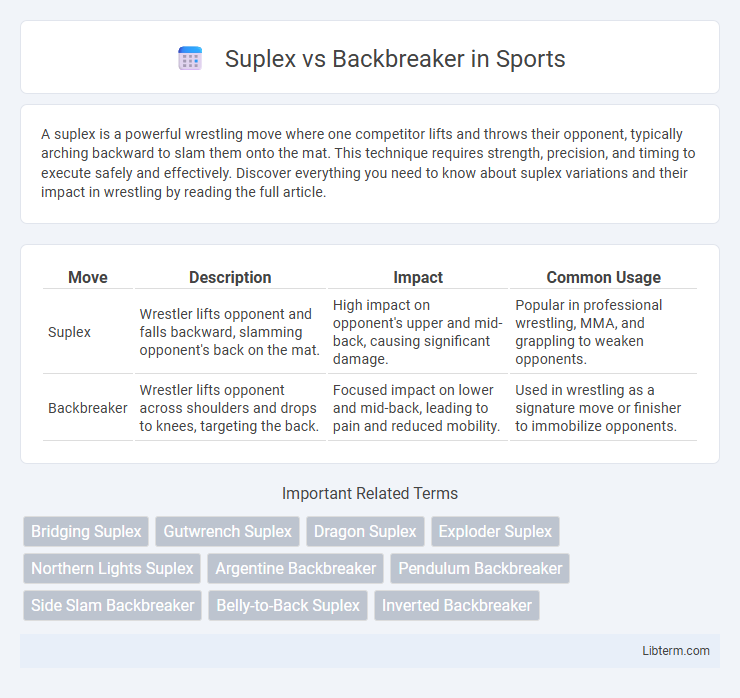A suplex is a powerful wrestling move where one competitor lifts and throws their opponent, typically arching backward to slam them onto the mat. This technique requires strength, precision, and timing to execute safely and effectively. Discover everything you need to know about suplex variations and their impact in wrestling by reading the full article.
Table of Comparison
| Move | Description | Impact | Common Usage |
|---|---|---|---|
| Suplex | Wrestler lifts opponent and falls backward, slamming opponent's back on the mat. | High impact on opponent's upper and mid-back, causing significant damage. | Popular in professional wrestling, MMA, and grappling to weaken opponents. |
| Backbreaker | Wrestler lifts opponent across shoulders and drops to knees, targeting the back. | Focused impact on lower and mid-back, leading to pain and reduced mobility. | Used in wrestling as a signature move or finisher to immobilize opponents. |
Introduction to Suplex and Backbreaker
The suplex is a fundamental wrestling maneuver involving lifting the opponent and arching backward to slam them onto the mat, emphasizing control and leverage. The backbreaker targets the opponent's spine by raising and dropping them across the wrestler's knee or other body part, focusing on inflicting focused spinal damage. Both moves are essential in professional wrestling for disrupting an opponent's mobility and setting up for finishing techniques.
Historical Origins of Suplex and Backbreaker
The suplex originated in amateur wrestling and was popularized in professional wrestling during the early 20th century, emphasizing leverage and throw techniques rooted in Greco-Roman and freestyle wrestling. The backbreaker, evolving from traditional wrestling holds, gained prominence as a signature move in the mid-20th century, designed to visually emphasize spinal impact and pain. Both maneuvers highlight the sport's blend of theatricality and technical skill, with the suplex showcasing athleticism and the backbreaker emphasizing targeted damage.
Key Differences Between Suplex and Backbreaker
The primary difference between a suplex and a backbreaker lies in the execution and impact area; a suplex involves lifting the opponent and throwing them backward, targeting the neck and spine, whereas a backbreaker focuses on dropping the opponent's back across the wrestler's knee or another hard surface. Suplex variations, such as the German suplex or vertical suplex, emphasize momentum and control, while backbreakers like the spinebuster prioritize compressing the vertebrae to inflict damage. Both moves are staples in professional wrestling, with suplexes generally aiming for pinning opportunities and backbreakers designed to weaken the opponent's back for sustained advantage.
Suplex Variations and Execution Techniques
Suplex variations include the German suplex, belly-to-back suplex, and vertical suplex, each emphasizing different body control and leverage points to maximize impact. Execution techniques require precise grip positioning, hip thrusting, and timing to safely lift and rotate the opponent while maintaining balance and momentum. Mastery of suplex mechanics enhances power delivery and visual impact in professional wrestling and combat sports.
Backbreaker Types and Signature Moves
Backbreaker variations include the Traditional Backbreaker, where the opponent is slammed across the attacker's knee, and the Elevated Backbreaker, adding greater impact by lifting the opponent higher. Signature moves such as the Argentine Backbreaker Rack isolate the opponent's back while applying pressure, and the Backbreaker Drop delivers a sudden, forceful impact to the spine. These backbreaker techniques target the opponent's back, aiming to weaken and immobilize through precise spinal and muscle strain.
Impact on Opponents: Suplex vs Backbreaker
The suplex delivers a powerful vertical impact, lifting and driving the opponent backward onto their upper back or shoulders, often targeting the spine and neck with high force, which can temporarily stun or disorient. In contrast, the backbreaker focuses concentrated pressure directly onto the opponent's lower back or lumbar region by dropping them across the wrestler's knee or arm, causing intense localized pain and potential longer-term damage. Both moves compromise the opponent's mobility but suplexes emphasize high-impact shock, while backbreakers exploit targeted spine compression for sustained injury.
Famous Wrestlers Known for Suplexes
Famous wrestlers known for suplexes include Kurt Angle, Brock Lesnar, and Chris Benoit, each renowned for their technical prowess and powerful execution of various suplex maneuvers. Angle popularized the ankle lock and Olympic-style suplexes, Lesnar combined suplexes with suplex variations like the German suplex for dominance, and Benoit was celebrated for his precision and intensity in delivering suplexes. These wrestlers elevated the suplex as a signature move, contrasting with the impactful Backbreaker executed by stars such as Triple H and Randy Orton.
Iconic Wrestlers Who Use Backbreakers
The backbreaker is a signature move famously used by iconic wrestlers such as Shawn Michaels, known for his distinctive "Sweet Chin Music" and impactful backbreaker variations, and The Undertaker, who often incorporates it into his devastating finisher sequences. Unlike the suplex, which primarily targets lifting and flipping opposing wrestlers, the backbreaker focuses on sudden, forceful impact on the opponent's spine, emphasizing pain and control. Wrestlers like Chris Jericho and Triple H have also popularized unique backbreaker techniques that showcase their strength and technical prowess in the ring.
Suplex vs Backbreaker: Fan Perspectives
Fan perspectives on Suplex vs Backbreaker highlight a passionate debate emphasizing the intensity and impact of each move. Suplexes are praised for their dynamic aerial execution and versatility in match storytelling, while backbreakers receive acclaim for their brutal targeting of the opponent's spine, generating a sense of vulnerability. Wrestling enthusiasts often value the suplex for its high-energy spectacle and technical skill, contrasting with the backbreaker's perceived raw power and damage-centric appeal.
Conclusion: Which Move Dominates the Ring?
The suplex dominates the ring with its versatile variations and high-impact execution, often targeting an opponent's entire body for maximum control and damage. The backbreaker delivers focused spinal compression, making it a powerful opponent counter and pain-inflicting maneuver. In ring dominance, the suplex's adaptability and crowd-pleasing spectacle generally grant it superiority over the backbreaker.
Suplex Infographic

 libterm.com
libterm.com